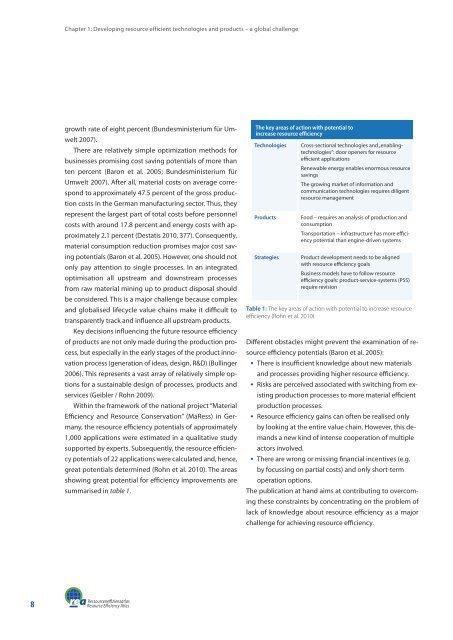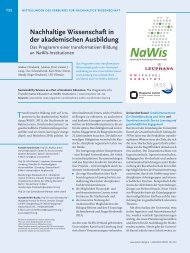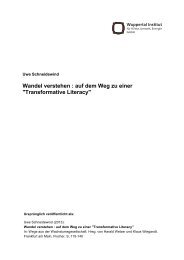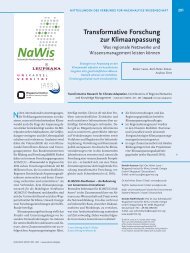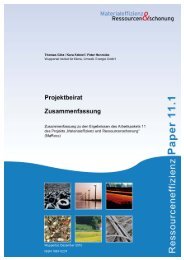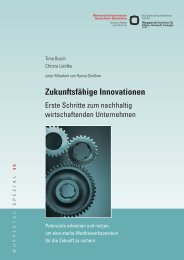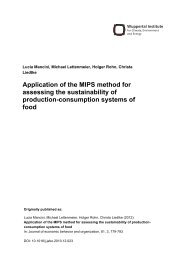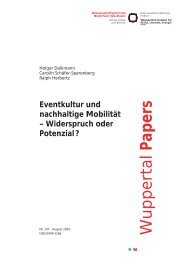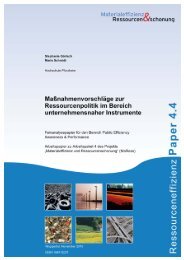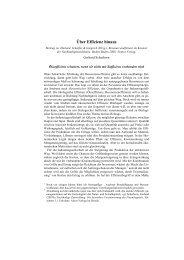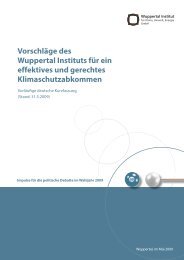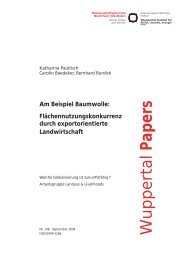Resource Efficiency Atlas - Publication Server of the Wuppertal ...
Resource Efficiency Atlas - Publication Server of the Wuppertal ...
Resource Efficiency Atlas - Publication Server of the Wuppertal ...
Create successful ePaper yourself
Turn your PDF publications into a flip-book with our unique Google optimized e-Paper software.
8<br />
Chapter 1: Developing resource efficient technologies and products – a global challenge<br />
growth rate <strong>of</strong> eight percent (Bundesministerium für Um-<br />
welt 2007).<br />
There are relatively simple optimization methods for<br />
businesses promising cost saving potentials <strong>of</strong> more than<br />
ten percent (Baron et al. 2005; Bundesministerium für<br />
Umwelt 2007). After all, material costs on average correspond<br />
to approximately 47.5 percent <strong>of</strong> <strong>the</strong> gross production<br />
costs in <strong>the</strong> German manufacturing sector. Thus, <strong>the</strong>y<br />
represent <strong>the</strong> largest part <strong>of</strong> total costs before personnel<br />
costs with around 17.8 percent and energy costs with approximately<br />
2.1 percent (Destatis 2010, 377). Consequently,<br />
material consumption reduction promises major cost saving<br />
potentials (Baron et al. 2005). However, one should not<br />
only pay attention to single processes. In an integrated<br />
optimisation all upstream and downstream processes<br />
from raw material mining up to product disposal should<br />
be considered. This is a major challenge because complex<br />
and globalised lifecycle value chains make it difficult to<br />
transparently track and influence all upstream products.<br />
Key decisions influencing <strong>the</strong> future resource efficiency<br />
<strong>of</strong> products are not only made during <strong>the</strong> production process,<br />
but especially in <strong>the</strong> early stages <strong>of</strong> <strong>the</strong> product innovation<br />
process (generation <strong>of</strong> ideas, design, R&D) (Bullinger<br />
2006). This represents a vast array <strong>of</strong> relatively simple options<br />
for a sustainable design <strong>of</strong> processes, products and<br />
services (Geibler / Rohn 2009).<br />
Within <strong>the</strong> framework <strong>of</strong> <strong>the</strong> national project “Material<br />
<strong>Efficiency</strong> and <strong>Resource</strong> Conservation” (MaRess) in Germany,<br />
<strong>the</strong> resource efficiency potentials <strong>of</strong> approximately<br />
1,000 applications were estimated in a qualitative study<br />
supported by experts. Subsequently, <strong>the</strong> resource efficiency<br />
potentials <strong>of</strong> 22 applications were calculated and, hence,<br />
great potentials determined (Rohn et al. 2010). The areas<br />
showing great potential for efficiency improvements are<br />
summarised in table 1.<br />
Ressourceneffizienzatlas<br />
<strong>Resource</strong> <strong>Efficiency</strong> <strong>Atlas</strong><br />
The key areas <strong>of</strong> action with potential to<br />
increase resource efficiency<br />
Technologies Cross-sectional technologies and „enablingtechnologies“:<br />
door openers for resource<br />
efficient applications<br />
Renewable energy enables enormous resource<br />
savings<br />
The growing market <strong>of</strong> information and<br />
communication technologies requires diligent<br />
resource management<br />
Products Food – requires an analysis <strong>of</strong> production and<br />
consumption<br />
Transportation – infrastructure has more efficiency<br />
potential than engine-driven systems<br />
Strategies Product development needs to be aligned<br />
with resource efficiency goals<br />
Business models have to follow resource<br />
efficiency goals: product-service-systems (PSS)<br />
require revision<br />
Table 1: The key areas <strong>of</strong> action with potential to increase resource<br />
efficiency (Rohn et al. 2010)<br />
Different obstacles might prevent <strong>the</strong> examination <strong>of</strong> re-<br />
source efficiency potentials (Baron et al. 2005):<br />
There is insufficient knowledge about new materials<br />
and processes providing higher resource efficiency.<br />
Risks are perceived associated with switching from existing<br />
production processes to more material efficient<br />
production processes.<br />
<strong>Resource</strong> efficiency gains can <strong>of</strong>ten be realised only<br />
by looking at <strong>the</strong> entire value chain. However, this demands<br />
a new kind <strong>of</strong> intense cooperation <strong>of</strong> multiple<br />
actors involved.<br />
There are wrong or missing financial incentives (e.g.<br />
by focussing on partial costs) and only short-term<br />
operation options.<br />
The publication at hand aims at contributing to overcoming<br />
<strong>the</strong>se constraints by concentrating on <strong>the</strong> problem <strong>of</strong><br />
lack <strong>of</strong> knowledge about resource efficiency as a major<br />
challenge for achieving resource efficiency.


